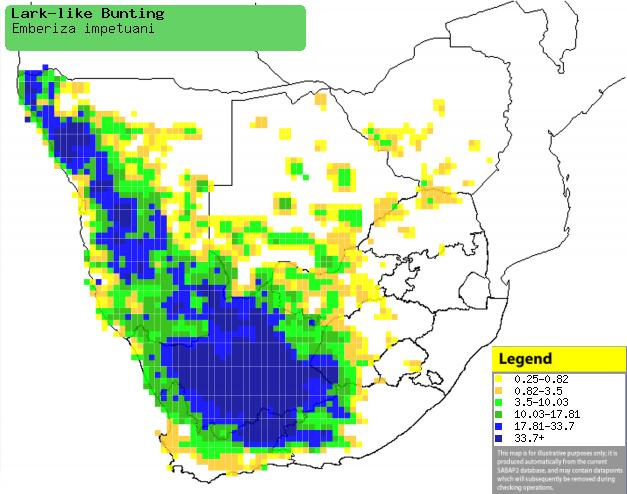|
Emberiza impetuani (Lark-like
bunting)
Vaalstreepkoppie [Afrikaans]; Leeuwerikgors [Dutch];
Bruant des rochers [French]; Lerchenammer [German]; Escrevedeira-cotovia
[Portuguese]
Life
> Eukaryotes >
Opisthokonta
> Metazoa (animals) >
Bilateria >
Deuterostomia > Chordata >
Craniata > Vertebrata (vertebrates) > Gnathostomata (jawed
vertebrates) > Teleostomi (teleost fish) > Osteichthyes (bony fish) > Class:
Sarcopterygii (lobe-finned
fish) > Stegocephalia (terrestrial
vertebrates) > Tetrapoda
(four-legged vertebrates) > Reptiliomorpha > Amniota >
Reptilia (reptiles) >
Romeriida > Diapsida > Archosauromorpha > Archosauria >
Dinosauria
(dinosaurs) > Saurischia > Theropoda (bipedal predatory dinosaurs) >
Coelurosauria > Maniraptora > Aves
(birds) >
Order: Passeriformes > Family: Fringillidae
Distribution and habitat
Occurs from southern DRC, Angola and western Zambia south
to southern to southern Africa. Here it is especially common in the western of
South Africa and Namibia, extending into Botswana, southern Zimbabwe and the
Limpopo and North-West Provinces. It generally prefers arid, open shrubland,
desert grassland, dry watercourses, sparse grassland or shrubland on rocky
ridges, eroded gullies, road verges and occasionally gardens of Karoo villages.
|
 |
|
Distribution of Lark-like bunting in southern
Africa, based on statistical smoothing of the records from first SA Bird
Atlas Project (©
Animal Demography unit, University of
Cape Town; smoothing by Birgit Erni and Francesca Little). Colours range
from dark blue (most common) through to yellow (least common).
See here for the latest distribution
from the SABAP2. |
Predators and parasites
It has been recorded as prey of
Glaucidium
perlatum (Pearl-spotted owlet).
Movements and migrations
As it prefers to live in arid areas it is
highly nomadic, travelling great distances in search of rainfall.
Food
It mainly eats grass seeds, foraging on bare ground with
scattered shrubs and stones. The following food items have been recorded
in its diet:
- Seeds
- grass
- Aristida (bristle grasses)
- Enneapogon
- Schmidtia
- Eragrostis (love grasses)
- Stipagrostis (bushman grasses)
- wheat
- forbs
- Atriplex semibaccata (Creeping saltbush)
- Insects
Breeding
- Monogamous solitary nester, building an untidy cup (see image below) of
coarse twigs lined with fine rootlets and the awns of desert grasses, such
as Bushman grass (Stipagrostis ciliata). It is typically placed on a
rocky ridge or on stony ground, often at the base of a small rock or beneath
a shrub.
- Egg-laying season varies according to rainfall, but it is generally from
September-April.
- It lays 2-4 eggs, which are incubated for about 11-13 days.
- Little is known about the chicks, other then that they stay in the nest
for about 12-13 days.
Threats
Not threatened.
References
-
Hockey PAR, Dean WRJ and Ryan PG 2005. Roberts
- Birds of southern Africa, VIIth ed. The Trustees of the John Voelcker
Bird Book Fund, Cape Town.
|
